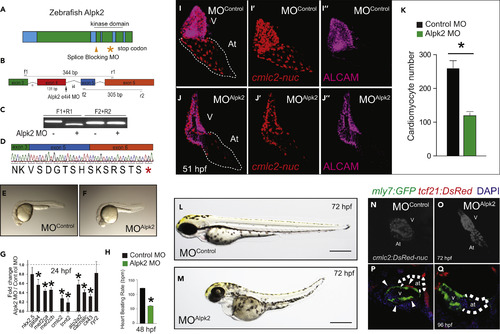Fig. 2
- ID
- ZDB-FIG-180817-27
- Publication
- Hofsteen et al., 2018 - ALPK2 Promotes Cardiogenesis in Zebrafish and Human Pluripotent Stem Cells
- Other Figures
- All Figure Page
- Back to All Figure Page
|
Alpk2 Is Essential for Zebrafish Cardiac Development (A) Zebrafish Alpk2 locus and targeted region by splice-blocking morpholinooligonucleotides (MO). * denotes stop codon. (B–D) RT-PCR and Sanger sequencing demonstrating splice-blocking MO caused alternative splicing resulting in a 131-base pair deletion and premature stop codon. * denotes stop codon. (E and F) Zebrafish injected with negative control MO (E) or Alpk2 MO (F) at 24 hr post fertilization (hpf). (G and H) Transcript analysis (G) and heart beating rate (H) of control and Alpk2 morphants at 24 and 48 hpf, respectively (N = 5, 15–22 pooled embryos per N). (I–O) Representative images of control and Alpk2 MO-injected hearts carrying a transgene for cmlc2:DsRed-nuc to quantify cardiomyocyte nuclei (K) at 51 hpf (N = 7–9). Red denotes cmlc2:DsRed-nuc and magenta is antibody staining for activated leukocyte cell adhesion molecule (ALCAM). Representative bright-field images of control MO (L) and Alpk2 MO (M) injected zebrafish at approximately 72 hpf. Representative images of control MO (N) and Alpk2 MO (O) injected zebrafish hearts carrying a transgene (cmlc2:DsRed-nuc) to denote cardiac morphology at approximately 72 hpf. (P and Q) Confocal images of control and Alpk2 morphant fish carrying myl7:GFP and tcf21:DsRed at 96 hpf. White arrowheads denote tcf21+ epicardial cells on the heart ventricle. N = 3; independent biological replicates with 45–76 pooled animals per N unless otherwise noted. Data are mean ± SEM; * denotes p ≤ 0.05. |
| Genes: | |
|---|---|
| Fish: | |
| Knockdown Reagents: | |
| Anatomical Term: | |
| Stage: | Prim-5 |
| Fish: | |
|---|---|
| Knockdown Reagents: | |
| Observed In: | |
| Stage Range: | Prim-5 to Day 4 |

